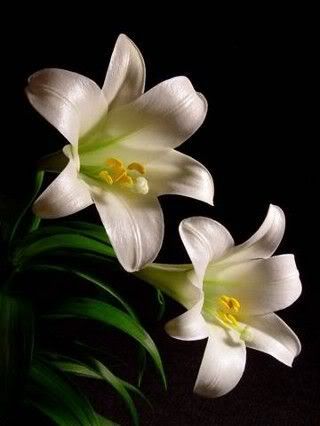Beautiful Life of the Easter Lily
Linda H. Yates*
Lilium longiflorian, Latin name for Easter Lily, is native to the Ryukyu Islands of southern Japan. Their journey to the altars and homes of Christian people, exactly on schedule for varying dates of Easter observances, is a long one.
Japan was the source for most of the bulbs coming to the U.S. before 1941. When the Japanese attacked Pearl Harbor in 1941, Japan lost the American market.
Growers along the California-Oregon border began production and now harvest 95% of all bulbs for the potted Easter Lily trade, shipping more than 12 million each year to the U.S. and Canada. The bulbs are harvested in the fall and sent to commercial greenhouses where they are potted and forced to bloom in time for the Easter holiday. Since Easter falls on a different day each year, the first Sunday that follows the first full moon after the vernal equinox, conditions are carefully controlled in commercial greenhouses to force blooms with no margin for error.
From bulblet to mature blooming flower, Easter Lilies require from two to three years to grow and are handled as many as 40 times. It was so convenient and inexpensive to place one or two or dozens in homes and churches today that the hard and skilled labor of growing them may be overlooked. Tomorrow, they may be abandoned on doorsteps or in trash bins.
Their beauty of form and symbolism deserves better. Your Easter Lily symbolizes life so let it continue to live. To keep them in your home, as the flower bulbs mature, remove the yellow anthers before the pollen drops on the white petals or on the furniture. As a flower withers, cut it off so you can better enjoy the fresher, newly-opened blooms. Remove any plastic wrapping around the pot that will hold water and cause the bulb to rot.
Easter Lilies are perennials and will grow in your garden as do other lilies. When all the flowers are spent, remove the plant from the pot and place it in a sunny spot outside. Plant the Easter Lily bulb three inches below ground level in rich organic matter, a mixture of soil, peat moss and compost. Water in well, leaving no air pockets. Slow release fertilizer may be added. Mulch well.
Easter Lilies naturally bloom in summer, probably June or July in Tallahassee. (In PA, they do very well planted in the garden after Easter is over... Thane) They emerge from winter dormancy in January or February. Given adequate water, sunshine and nourishment, they will add beauty, grace and tranquility to your garden next year and for years to come.
*Linda H. Yates is a Master Gardener volunteer with the University of Florida IFAS Extension in Leon County and a member of its Horticultural Advisory Committee.

 Posted by
Posted by

2 comments:
Thane,
Very nice, I learn something new everyday reading your blog. Your just an encyclopedia of information. (lol). Great post once again.... Tammy
PS to it... the one I transplanted this year is doing just fine! It's thriving next to the ones from previous years!
Post a Comment